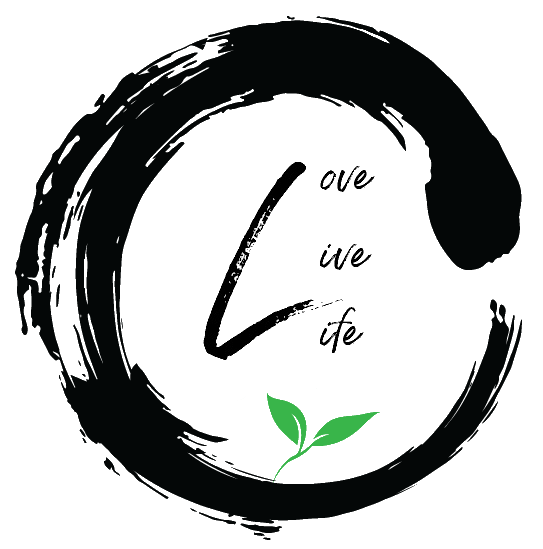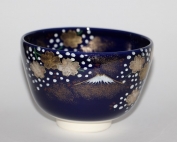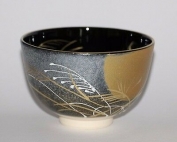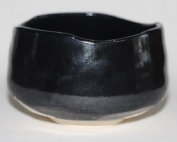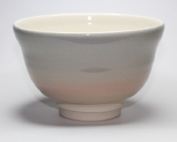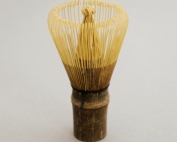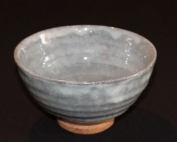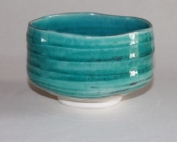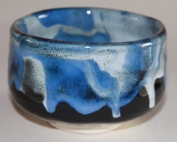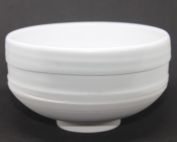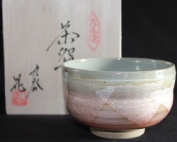The Matcha (抹茶) was originally imported from China to Japan. It is a typically bright green powder, which is obtained by a grinding process from the whole tea leaves. The powder is usually sieved for preparation before brewing and afterwards beaten foamy with a special bamboo broom.
Matcha Tea
Traditionally, the tea culture in Japan has been significantly influenced by the much older Chinese since then, but over time it has also shaped its own traits.
The matcha also took part in this development: In the beginning, the production of the Japanese Matcha naturally strongly relied on the then typical Chinese process, but in the course of time, more and more sophisticated manufacturing processes were devised by the Japanese tea experts. But also in China, the Matcha has been subject since its early days, a continuous continuous development both in terms of the preparation process as well as in terms of the leaves or plant components used.
For this reason, different green tea powders are called Matcha, even if they are not necessarily made in the traditional way. In the eyes of many experts, this is an aspect that vividly illustrates the richness of Far Eastern tea culture.
Matcha – harvest and production
Also for the high-quality Matcha, as with other high-quality Japanese green teas, there is a manual selection of the leaves suitable for further processing into the powder before harvesting.
Again, opinions on which leaves are most suitable for matcha manufacture have changed over the centuries in both Chinese and Japanese space. Modern matcha is usually obtained from green tea, whose leaves are prevented by a pronounced shading to the formation of too high a concentration of bitter substances.
The traditional shading by dried rice grass has meanwhile given way to more modern shading through nets. These offer many practical advantages during harvesting and are usually roof-like over the plantations to be shaded, but also over individual plants. Many more traditionally hand-harvesting tea farmers choose the sprawling roofs of nets as their means of shading.
These make the use of modern mechanical aids in the harvest during the shading period largely impossible – but these Japanese tea farmers are already convinced by harvesting by hand, the quality of the harvested tea to greatly increase and thus to enable the production of a particularly high quality matcha.
However, to be able to benefit from the very efficient modern harvesters, the harvest is often split in time into a manual harvest and a mechanical harvest. Before the latter, the spanned networks are then removed.
Matcha
This often leads to misunderstandings about the exact process of manual harvesting. In particular, many tea-loving Europeans are often of the opinion here that the entire tea plant is harvested by hand. Such a rabid process would, however, completely miss the purpose of the harvest by hand. Because this is rather a very careful selection process, which selectively selects only the finest leaves for later processing.
One must not forget: The tea farmers are often experts in whose families tea cultivation has a long tradition. Accordingly sensitively here also with the tea plants is handled. Thus, the whole tea plants are not harvested, but only the leaves suitable for the further processing to matcha are selected with the practiced eye at the respective harvest time. Only after this procedure, the rest of the tea is harvested with machine help.
Naturally, the yield of the hand harvest is relatively low compared to the mechanical harvest, but the quality is all the higher. In some of Japan’s traditional tea-growing regions, even exact agreements are made about the exact timing of the tea harvest.
After harvesting, the harvested leaves are then typically processed in stone mills to matcha powder. This process takes a lot of time, but if expertly carried out, it guarantees the tea lover a particularly high-quality product, in which the full potential of the harvested tea leaves has been exploited and biologically opened up.
The valuable ingredients of the green tea are after the professional brewing from the resulting tea powder particularly easily accessible to the human organism. This is especially true for the harmful oxidation processes inhibiting herbal tea-inherent substances, but also for many more contained in green tea health-promoting agents.
Matcha caffeine
If you take a look at the amount of caffeine in Matcha tea, you would get really dizzy.
Compared with a cup of strong coffee, Matcha tea has amount of caffeine that is several times higher.
This may deter some people at first, they are afraid to feel about the negative effects of caffeine that they had experience from coffee when drinking matcha tea in a much stronger form.
However, if the person affected does the experiment of having a cup of Matcha tea, he will be extremely amazed that the feared effect does not occur.
On the contrary:
Matcha tea ensures that you feel physically and mentally balanced, but still fit and productive.
Caffeine in the matcha
This combination is unique:
On the other hand, an attentive, alert state of mind and an extremely powerful body feeling, on the other hand complete serenity, confidence and the feeling that you could handle and do everything.
However, we want to delve deeper into the matter and take a closer look at the effects of caffeine in Matcha tea. Matcha tea contains about 0.34 grams of caffeine per ten grams of weight.
To understand clearly, you have to compare the amount of caffeine with the other drinks also.
For example, normal green tea only has 0.02 grams of caffeine per ten grams. Coffee has about three times the amount of caffeine, i.e. about 0.06 grams per ten grams of coffee powder.
As you can see, Matcha tea has more than six times the amount of caffeine that compared with normal coffee.
Now you have to consider that the active ingredient caffeine is not always absorbed by the body in the same way.There is a considerable difference here, particularly between coffee and tea.
Coffee is particularly known as a wake-up agent. In it, the caffeine takes effect in a very short time, but it only lasts for a very short time. For example, coffee is not a good recommendation for tired drivers because the stimulant effect lasts for a few minutes at most and the tiredness only increases afterwards. In this case it would be better to drink a cup of Matcha tea.
A combination of the caffeine in the tea with the so-called polyphenols means that the pure caffeine only dissolves very slowly in the intestine and is therefore also released to the organism just as slowly.This causes a delayed effect of caffeine, which is much gentler and also lasts much longer.
You could say casually:
The caffeine contained in the Matcha tea does not offer the kick of a coffee, but it is much gentler and longer lasting in the body. mFor the reasons mentioned, it is also not a problem to drink several cups of Matcha tea a day. In most cases, experts recommend consuming around three cups of Matcha tea a day. This is the best way for all ingredients to work, and the high caffeine content does not cause any problems.
Ingredients Matcha tea
Whoever drinks Matcha regularly benefits from its great ingredients, which have a positive effect not only on the body but also on the mind.
It is therefore recommended to take Matcha tea in several small portions a day, preferably every day. The best effect of the ingredients unfolds at a rate of about 3 cups a day. Alternatively, the Matcha tea powder can also be stirred into other foods, such as cold shakes, soups, ice cream, desserts, etc. Meanwhile, there are even manufacturers who offer chocolate with Matcha tea.
- Caffeine
- Amino acids such as L-theanine
- catechins
- Antioxidants
- Chlorophyll
- Calcium
- Proteins
- Iron
- Potassium
- Vitamin A
- Vitamin B1
- Vitamin B2
- Vitamin B3
- Vitamin E
- Vitamin K
- Vitamin C
Just by the amount of vitamin C contained can be quickly determine how valuable the tea really is, it contains more vitamin C than an orange. Caffeine helps to make you feel more alert and fit. In contrast to the caffeine derived from coffee, that of the Matcha tea is released only in the intestine.
The awakening effect occurs here later, but holds relatively much longer.
The body is unable to produce calcium itself, which is why this mineral must be absorbed through the diet to prevent subfunction of the body. The Matcha forms the perfect basis due to its calcium content. The calcium is needed to support bone formation and tooth preservation. A calcium deficiency can therefore be quite fast affect negatively. Also for the heartbeat and a well-functioning nervous system, this mineral is essential.
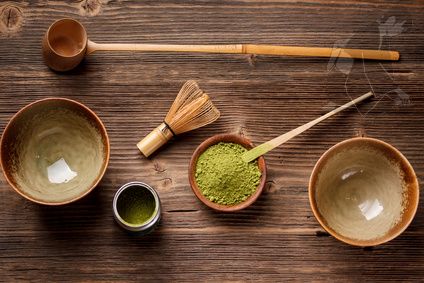 Calcium relieves pain and itching, but at the same time stimulates blood clotting and iron metabolism. To form hemoglobin, the blood pigment, iron is urgently needed by the body. Hemoglobin transports oxygen into the cells of the body. If you take in healthy amounts of iron, this prevents the risk of illness. Fatigue states are also significantly reduced.
Calcium relieves pain and itching, but at the same time stimulates blood clotting and iron metabolism. To form hemoglobin, the blood pigment, iron is urgently needed by the body. Hemoglobin transports oxygen into the cells of the body. If you take in healthy amounts of iron, this prevents the risk of illness. Fatigue states are also significantly reduced.
Potassium is a mineral that provides optimal blood pressure and therefore should not be missed. In general, minerals are extremely important to the health of the human body, but only if they are in the right mix and in the optimal dosage. Tests and studies have shown that an excess supply of certain minerals can even have a negative impact on the body. Incidentally, the same applies to the area of vitamins, which we will now discuss.
Vitamins need to be taken daily as they are responsible for many actions in the body. They are needed for skin formation, promote the development of mucous membranes and tissue, but also contribute to energy. A healthy immune system and stable nerves are also only achieved by the sufficient intake of different vitamins. Vitamins and provitamins are equally important for the body.
A good example of this is vitamin C:
No other vitamin works so strongly on the immune system of humans. Those who do not eat enough of them get a cold in the cold months and are generally susceptible to all kinds of infectious diseases.
Matcha – health
Matcha is a form of green tea that has been ground into powder.
Matcha is made in Japan from Tencha and our information presupposes this type of green tea.
This means that Matcha can be made from any green tea, but the health benefits relate to Matcha made from Tencha.
Matcha tea can have an even greater health benefit as it is taken in its entirety.
Matcha tea – Japan’s popular powder
Matcha tea is a very rich source of antioxidants, polyphenols, fiber and vitamin C.
A bowl of Matcha has the antioxidant power of about 10 cups of conventional green tea and about 15 times the amount of antioxidants compared to a pomegranate.
We have been researching Matcha tea for some time, but there are still insufficient studies on Matcha. However, since Matcha is a concentrated form of green tea, it can be assumed that the benefits of green tea are at least transferable to Matcha tea.
The L-theanine in Matcha is an amino acid that promotes relaxation and well-being.
The beta waves working in the brain are responsible for a stimulated and excited feeling state, which the alpha waves generated by L-theanine counteract and create a state of relaxation.
L-theanine is usually present in every tea, but it is found in Matcha tea in a concentrated five times the amount of black or green tea. L-Theanine can increase learning and memory performance due to its abilities. Matcha tea is a unique class of antioxidants called catechins and the most important to health is probably the catechin EGCG (epigallocatechin gallate).
This is said to have strong anti-cancer properties, protect cells from DNA damage and even inhibit tumor growth. Cancer prevention is also attributed to the very strong antioxidants polyphenols, although the exact mechanisms are still unknown.
Matcha tea – health effects
The green tea owes its juicy green color to the element chlorophyll.
Green tea that grows in the shade like Tencha or Gyokuro is much richer in chlorophyll than other green tea. Laboratory studies have shown that polyphenols can reduce tumor growth and that cancer rates are lower in countries where a high level of green tea is consumed. Of course, it is not possible to attribute this phenomenon to the consumption of green tea alone.
In an eleven-year study on more than forty thousand Japanese, it was demonstrated that consumption of at least 5 cups of green tea a day can significantly reduce the risk of cardiovascular disease.
Although this large-scale study with participants between the ages of forty and seventy-nine was not specifically investigated with Matcha, it can at least be assumed that Matcha tea is much more potent than conventional green tea that the same effects can certainly be achieved.
Matcha – preferably every day
There are many ways to include Matcha in your diet. It is best to enjoy Matcha tea pure.
To do this, stir about 1-2 grams of matcha with about 40-60 ml of water into a matcha bowl provided for this. Lower quality matcha can be used to mix in yogurt, milk, ice cream or cereal.
If you are very sensitive to caffeine, we do not recommend consuming it after three o’clock in the afternoon. If necessary, talk to your family doctor or alternative practitioner whether there is an increased risk for you.
A healthy diet is the most important prevention of diseases, it is diverse and must consist of individual vegetarian foods.This should be taken into account in any diet.
Matcha qualities
As already mentioned several times, the real Japanese Matcha tea is made exclusively from the Tencha leaves. First you remove the fine leaf veins and the style, so that only the bare leaves can be processed into this fine tea powder.
The processing process is complex and therefore very expensive: It requires special mills, which are made by experienced stonemasons especially for Matcha production, to finally get a high quality end product. In these mills, the prepared tea leaves are then ground for several hours at a slow speed until the fine, soft powder of Matcha tea is produced.
The following applies here:
The finer, the better. As the procedure is so complex and time-consuming, this is of course reflected in the price of the Matcha tea again. A good matcha tea can cost 100 grams per 100 grams, in some cases even more.
In view of this fact, it is not difficult to understand that more and more manufacturers are coming to market, who are said to be offering matcha tea at very reasonable prices, but who do not believe it to be genuine, i. traditionally made matcha turns out.
So you can recognize such fakes, here are some important hints:
You should first look closely at the color of the tea powder. Genuine and high quality Matcha tea from Japan has a fresh, grassy green color, also called jade green. It illuminates you from the tin or packaging, so to speak. Qualitatively inferior Matcha teas or counterfeits, on the other hand, have a much paler color, which often turns out to be either too pale (it almost goes yellowish), or it is a very dark tea powder that shows a dark green or brownish color.
In order to be able to optimally check whether you have a real, i. high quality matcha tea, you should ideally be able to prepare a small amount of it. Particular attention should be paid to the resulting aroma. Genuine Matcha tea develops a very fine, light aroma, reminiscent of the smell of fresh seawater. On the other hand, if the ready-made tea smells sour or already bitter, it certainly is not a high-quality, genuine Matcha tea.
Finally, the last information about the quality of the tea gives the taste. Japanese speak of the fifth sense of taste or umami, which is awakened by the enjoyment of Matcha tea in the mouth. Since the Europeans usually can not imagine anything, the taste is best described with a fine aroma, which leaves a sweet, green aftertaste in the mouth after swallowing. No nuance should taste too much out of the tea, all ingredients must form a fine and smooth flavor composition.
Finally, an important tip:
Buy Matcha tea exclusively from the retailer you trust, no matter whether on the Internet or in real life. Always ask where the tea came from and whether it was made from real Tencha leaves. Let the tea powder show in advance and, if possible, make an odor and taste test. A trader who has nothing to hide will be happy to make you a small amount of the tea and taste it for you.
Matcha – preparation – recipes & refinement
The preparation of the Matcha tea cannot be compared to the brewing of a “normal” tea drink. First of all you need a so-called Matcha bowl, the “Matchawan”. You will also need a Matcha broom – the “Chasen” – and a bamboo spoon – the “Chashaku”. This green tea has been enjoyed in Japan for many hundreds of years with a very special ceremony, which was also well received by German fans.
The preparation of the tea is an inevitable part of this ceremony.
In the first step, the bamboo broom is placed in the matcha bowl and then hot water is poured into the bowl. This should preheat the bowl and broom. In addition, the broom must be soaked for between 10 and 20 minutes in order to be able to “process” the tea as best as possible. After 20 minutes at the latest, the water must be poured out before the green tea powder is added to the bowl.
About two bamboo spoons full (approx. 2 g) are enough to achieve the perfect variety of flavors.
Many first-time users assume that 2 grams of tea are clearly too little. However, this is not the case, because the powder is dosed much higher than is the case with conventional tea preparations.
If the personal taste prefers a little more or less powder, the amount can of course be adjusted to your own needs. At first glance, the intense color that is the “trademark” of the tea will stand out. In addition, the tea smells wonderfully refreshing. The Matcha tea may clump a little. In such a case, very little cold water should be added first and whipped until creamy with the broom.
Only then can the hot water be poured over. If the hot water were used immediately, the lumps would not dissolve, which harms tea enjoyment. To brew the tea, the water should have a temperature that is between 80 and 90 ° C. 60 to 70 ml of water are sufficient to conjure up a delicious hot drink. Only after adding the water do you take the step that makes Matcha tea unique. This requires the broom that is held by the handle. The index finger, middle finger and ring finger should enclose the handle.
Right-handed people hold the chase in their right hand, left-handed person in their left hand. To guarantee that the bowl cannot slip when stirring, it should be held with your free hand. If you can’t get the tea open so well while sitting, you can of course stand up for this.
The tea is now opened by rapid stirring movements.
Important:
The broom must not touch the bottom of the bowl and should be guided in the shape of an “M” to achieve the best result.
Anyone who finds opening the tea a nuisance should consider it a positive challenge, because preparing is just as much a tradition as enjoying the popular drink afterwards.
It is not difficult to find out. As soon as the matcha has a lush foam layer that is blistered, it can be enjoyed.
The delicious Matcha tea comes into its own when it is consumed with something sweet. This is also part of the ritual popular in Japan.
Matcha recipes
Matcha can not only be enjoyed hot, but also as a cold drink.Due to its positive effects on the entire body, the cold Matcha tea is especially recommended for athletes.
The contained EGCG catechin helps to prevent sore muscles. On the one hand, muscle building is promoted by this ingredient, on the other hand, muscle fibers are protected.
In general, good green tea like Matcha not only benefits athletes, but everyone who drinks it. After all, it makes you lively, fit and helps you to concentrate well.
The optimal shake for sports
If you want to enjoy Matcha as a cold sports drink, you can prepare the tea as a shake.
In combination with soy milk, for example, it offers other important protein components for the athlete. Therefore, matcha tea should be drunk before exercising. In general, this green tea is very popular as a shake, and not only because of its refreshing color.
The vitalizing effect and great taste are well received by consumers, so that more and more Germans are committed to Matcha tea.
Recipe for a fresh shake
Ingredients:
2 – 4 bamboo spoons of matcha
100ml soy milk
2 – 3 teaspoons of coconut
½ lemon
1 handful of cranberries
Preparation:
Juice the lemon. Pour the juice with pulp together with the other ingredients into a blender and mix vigorously. The perfect shake – a power cold drink for all athletes – can be served after just a few seconds.
More cold drinks with Matcha tea
Many health-conscious people swear by making matcha tea with almond milk instead of soy milk.
This gives a particularly “round” taste, since the almond milk harmonises perfectly with the aroma of the Matcha. In addition, almond milk is also said to have a very health-promoting effect, so that these two ingredients complement each other very well.
Recipe for matcha shake with almond milk
Ingredients:
250 ml almond milk
2 tbsp agave syrup
1 tsp matcha tea
1 pinch of bourbon vanilla
If desired: 1 handful of cranberries, blueberries etc. or 1 banana
Matcha preparation:
Put all ingredients in a blender. Let the mixer run at low speed for about 30 seconds, then at high speed for 10 seconds.
If the almond milk is not yet nutty enough, you can also add hazelnuts or walnuts to the shake. It is advisable to prepare a larger amount of this shake straight away, the rest is kept in the fridge for 2-3 days. A sealed container should be used for storage, e.g. B. a pitcher with a lid.
Matcha tea finishing
Matcha tea is currently very trendy.
The intense green tea comes from Japan. It awakens the spirits in the morning and is considered a superfood with a top Orac value (Oxygen Radical Absobance Capacity / the capacity to absorb free oxygen radical) of 157,300 per 100 grams of tea powder. For example, dark chocolate has an ORAC of 22,700 and the ORAC of a pomegranate is 10,000. TE to 100 grams. These foods slow skin aging and, according to scientific knowledge, Matcha tea is at the top.
What is Matcha Tea?
The tea plant originally comes from China, where it has been used as a medicinal plant for thousands of years. It wasn’t until the 12th century that tea powder and the knowledge associated with it came to Japan.It was used for the tea ceremony as early as the 16th century.
How is the tea made?
The tea bush is evergreen. The tea plantations with Matcha plants are shaded with nets.
As a result, the leaves are enriched with certain ingredients that make the tea so valuable.
Either only the leaf tips or the whole leaves are used to extract the tea powder. They are treated with steam and then gently dried. Some leaves are ground to powder, while others are dried whole. The brighter the green color is, the fresher the tea is, because the green color fades when stored for a long time.
The ingredients
A cup of Matcha tea contains 30 mg of tea. The caffeine-like substance wakes you up, promotes concentration and creates a positive mood. The tea is milder than caffeine and is only released in the intestine. Theanine can be found in many shade teas and also in macha tea. It stimulates and stimulates. Experts suspect that theanine can be used to prevent diseases such as strokes, Parkinson’s and Alzheimer’s. Tannin has a disinfectant effect and soothes an irritated stomach.
A cup of Matcha tea also contains 4.2 mg calcium, iron potassium and vitamins B1, B2, C and carotene.
The health-promoting effect
Matcha tea contains many catechins.
Almost half of the leaves are made of it. Catechins are antioxidants. They inhibit skin aging, protect against the harmful effects of UV rays and reduce the formation of vascular plaques, which can cause arteriosclerosis. Epigallocatechin is one of the catechins.It is used to prevent cancer. The longer the green tea is drunk, the more pronounced the ingredients unfold.
What does the tea taste like?
The taste is not as intense as with green tea, but it is still bitter. It varies from fruity to nutty and is very aromatic.
Matcha preparation
The Matcha powder is available in tin cans or screw jars.
The traditional method of preparation requires a bowl, a bamboo spoon and a bamboo broom. Two spoons of matcha powder are mixed with a little cold water and a bamboo broom to form a thin, creamy paste. Now add 70 ml of water at around 80 degrees. The drink is whipped with the bamboo whisk. The traditional tea is ready. If you are not equipped with bamboo equipment, then a coffee spoon (use a heaped tip of powder here) and a whisk or milk frother will do the trick.
The low-viscosity matcha paste can be poured on with cow’s milk or soy milk and is a delicious shake in combination with cinnamon and ice cubes. Of course, Matcha tea is not the only type of tea that can be described as high quality and with a special aroma. Nevertheless, matcha tea is now considered a kind of fine tea, so to speak, but it is a very expensive pleasure to enjoy. In view of these facts, it is understandable that resourceful tea manufacturers have not only started offering pure matcha tea, but also used it to upgrade various leaf teas.
So that means:
These are traditional types of tea that are not ground and are prepared using the original method (by pouring hot water over them). Matcha tea powder is added to make these teas even finer in taste. The refinement of leaf teas through the addition of Matcha tea is not an invention of our time, with which the manufacturer wants to transfer something from the shine and glory of Matcha tea to other teas.
On the contrary:
Matcha tea powder was used early on to refine leaf teas. Traditionally, the classic Matcha tea type Tencha is used for this, but the Kukicha and Genmaicha varieties are also often used in this context.
The end product resulting from this type of preparation is called Matcha-iri Sencha in Japan.
These are Sencha tea leaves, to which a small amount of Matcha tea powder is added, which should create a more intense aroma.
In the cup, this type of tea is characterized by a more intense color and a finer aroma, compared to the preparation of Sencha tea in the form of leaves.
In addition, many other types of blends of leaf or stem teas to which matcha has been added have been invented over the centuries. For example with the Matcha-iri Kukicha.
The traditional Japanese stem tea called Kukicha is mixed with a little Matcha tea powder, which results in a tea of dark green color and an intense, sweet taste.
Tea is now even made from roasted rice, which is supplemented with Matcha powder and thus refined in its taste.
One speaks here of the Matcha-iri Genmaicha, which is a mixture of the said rice, Sencha tea leaves and some Matcha tea powder. Matcha tea is often used in western industry today to refine other types of tea.This does not always result in a finished drink that is really harmonious in its aroma and taste, in some cases the manufacturers only use the Matcha addition to give a cheaper end product a little more exclusivity and to be able to sell it at a higher price. However, true lovers of Matcha tea will not prefer the leaf teas refined with Matcha, but will continue to rely on traditional use.
After all, it was done this way hundreds of years ago, and it is unlikely that anything will change in the near future.
For many European tea drinkers, however, the mixture of leaf and matcha tea is a good alternative if they don’t want to stray too far from the usual tea enjoyment and the corresponding preparation.
